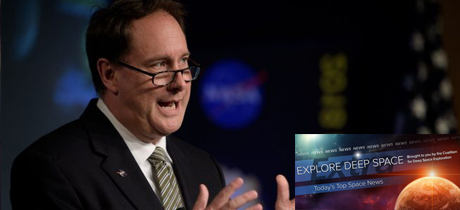In Today’s Deep Space Extra… NASA acting administrator Robert Lightfoot’s April 30 retirement plans place new urgency on establishing permanent agency leadership. Former Google Lunar X-Prize contestants forge ahead with commercial moon plans. Experts not ruling out habitable environments in the outer solar system.
Human Space Exploration
NASA acting administrator Lightfoot to retire
Space News (3/12): Robert Lightfoot, who’s led NASA as acting administrator since January 2017, a record, announced his retirement on Monday. Lightfoot, who will depart on April 30, promised a smooth transition. Meanwhile, the full U.S. Senate has yet to consider President Trump’s nomination of Jim Bridenstine, an Oklahoma Congressman, to lead the space agency. An engineer, Lightfoot joined NASA in 1989 at the Marshall Space Flight Center and went on to hold several high level posts.
Lightfoot retirement and impasse over Bridenstine puts NASA leadership in limbo
Spacepolicyonline.com (3/12): With NASA acting administrator Robert Lightfoot’s retirement set for April 30, NASA could face a leadership deficit if the White House and U.S. Senate are unable to agree on a full time successor. The Senate has so far been unable to come to an agreement on the nomination of Jim Bridenstine, an Oklahoma congressmen, over concerns he is not technically qualified. The agency also lacks a deputy administrator and chief financial officer. John Logsdon, founder of the George Washington University’s Space Policy Institute and a professor emeritus, is among those expressing leadership concerns for the agency at a critical point as it formulates plans to resume human deep space exploration and transition the International Space Station to public/private operations.
A new focus on exploration worries space technology advocates
The Space Review (3/12): NASA’s proposed 2019 budget would transition the agency’s stand alone Space Technology Mission Directorate into its Human Space Exploration and Mission Operations Directorate. While the merger may benefit NASA’s human space exploration ambitions, it could jeopardize advances in other “cross cutting” technologies needed for other pursuits, some are cautioning, among them two former heads of the technology directorate.
Space Science
Who needs $20 million? Moon race still on without Google’s Prize
Coalition Members in the News – Astrobotic and Lockheed Martin
Bloomberg Technology (3/11): With a lack of serious contenders, the Google Lunar X-Prize recently called off a competition among commercial companies to place functional hardware on the moon’s surface and transmit communications back to Earth. However, three teams from the U.S., Israel and Japan intend to forge ahead with their lunar development activities without the contest’s $20 million prize.
Could there be alien life right beneath the surface of icy worlds like Enceladus and Europa?
Universe Today (3/12): A recent analysis supported by the NASA Astrobiology Institute supports the prospect that life could emerge near submerged hydrothermal vents in the ice covered ocean environments of outer solar system planetary bodies, like Jupiter’s moon Europa; Saturn’s moons Titan, Enceladus and Dione; Neptune’s moon Triton; and the dwarf planets Ceres and Pluto.
You can hunt for alien planets in Kepler data using newly released Google code
Space.com (3/12): Google has released software code that enables citizen scientists to comb through data gathered by NASA’s Kepler space telescope in search of extra solar planets.
Other News
Vice President Mike Pence to speak at 34th Space Symposium
Space Foundation (3/12): Today the Space Foundation announced that Vice President Mike Pence will speak at the 34th Space Symposium in Colorado Springs, Colorado on Monday, April 16 at 12:00 pm, in a special presentation preceding the Symposium’s opening ceremony. “The Vice President’s participation at the Symposium indicates the priority the White House is placing on America’s position in space,” said Thomas E. Zelibor, Space Foundation Chief Executive Officer.
The Secretary of (Space) Commerce
The Space Review (3/12): In an interview, U.S. Secretary of Commerce Wilbur Ross outlines his concept for streamlining the regulatory environment for commercial space activities. “We don’t think that the regulatory process should be the gating element of a launch. It should be the technology and the production of the equipment,” notes Ross.
Blue Origin signs Sky Perfect JSAT as fourth New Glenn launch customer
Space News (3/12): Blue Origin has announced a fourth customer for its New Glenn commercial rocket, SKY perfect JSAT, of Tokyo.
SpaceX’s most recent launch carried a secret military-funded experiment
Spaceflightnow.com (3/12): SpaceX’s March 6 Falcon 9 launch from Cape Canaveral, Florida, carried a previously undisclosed U.S. military satellite, PODSat. The primary payload was the Hispasat communications satellite.

